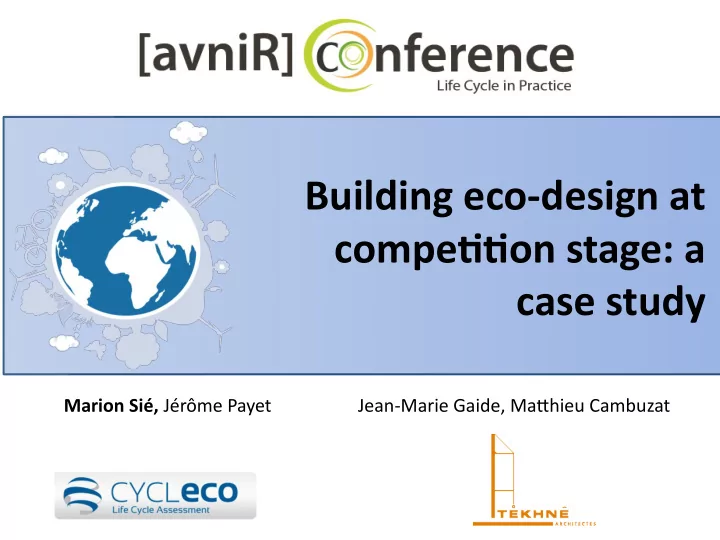

Building eco-design at competjtjon stage: a case study Marion Sié, Jérôme Payet Jean-Marie Gaide, Matuhieu Cambuzat
Content • Context, goal and scope • Eco-design process • Conclusions and perspectjves
Context, goal and scope
Context • Tekhnê Architectes made a proposal during an architectural design competjtjon for the constructjon of a secondary school. • Tekhnê included a Life Cycle Assessment (LCA) in their proposal. • Cycleco took over this LCA and decided to deepen the interpretatjon phase in order to use it as of a case study for training purposes.
Goal • Tekhnê’s objectjves: – Meet building owner’s requirement: assess embodied energy – Stand out from the competjtors by going one step further and providing a comparison of 2 scenarios on primary energy and climate change impacts • Cycleco’s objectjves: – Validate Tekhne’s conclusions by extending the analysis to a more complete set of indicators – Adjust design according to impacts results
Scope • Functjonal unit: “Provide an enclosed and insulated space of 1544m 2 fmoor area, with an energy consumptjon <120kWhep/m 2 /year, for use as a secondary school during 60 years.” • Scenarios: – a wood-framed building (favourite scenario) – a shutuered concrete building • System boundaries: – Structure, interior & fjnishing work packages – Included processes: manufacture, transport, installatjon, deconstructjon and landfjll of building products (constructjon and replacements)
Eco-design process
Firsts results 100% 0% Climate change Non-renewable primay energy
Extended set of indicators Human tox (non-carci) Mineral & fossil res. deplet° Climate change 100% Terrestrial and aquatjc acid. Respiratory inorganics 50% 0% Land use Water depletjon Human tox (carci) Fresh water eutroph. Fresh water ecotox. Ionizing radiatjon - HH Wood-framed building Shutuered concrete building
Comparison of structures Human tox (non-carci) Mineral & fossil res. deplet° Climate change 100% Terrestrial and aquatjc acid. Respiratory inorganics 50% 0% Land use Water depletjon Human tox (carci) Fresh water eutroph. Fresh water ecotox. Ionizing radiatjon - HH Wood-frame Shutuered concrete structure
Wood-framed building hot spots analysis Human toxicity Fresh water Ionizing Terrestrial and Resources (non- eutrophicatio radiations aquatic depletion carcinogens) n (HH) acidification Bio- Sealing Glazing Studs and tracks Mineral sourced Ceramic tiles Linole Other insulation Plaster insulation um boards
Comparison with a third alternatjve Human toxicity - non-carcinogens Mineral & fossil resources depletjon Climate change 100% Terrestrial and aquatjc acidifjcatjon Respiratory inorganics 50% 0% Land use Water depletjon Human toxicity - carcinogens Fresh water eutrophicatjon Fresh water ecotoxicity Ionizing radiatjon - HH Wood-framed building Shutuered concrete building Wood-framed building with wood beams
Conclusions and perspectjves
Study outcomes • It is of main importance to study the whole system • Hot spots analysis is a valuable tool for eco-design • It is of main importance to enlarge the scope of indicators • Hot spots analysis should be conducted on indicators for which the “a priori” favourite scenario is not the best • Eco-design is accessible to building professionals at competjtjon stage
Tool for intuitjve building eco-design Thank you Contact : marion.sie@cycleco.eu
Recommend
More recommend